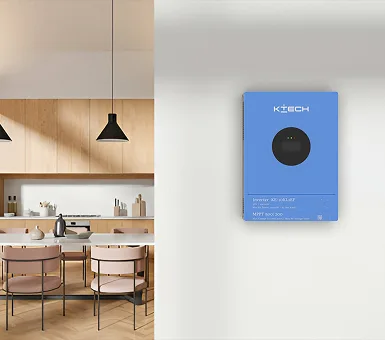In the smart building in Ginza, Tokyo, a set of hybrid inverters from Ktech Energy is simultaneously supplying power to the 50Hz power grid in Japan and imported equipment from the United States. The voltage fluctuation is always controlled within ±0.5%. In the solar power stations in the Sahara Desert, off-grid inverters of the same brand enable the 60Hz pumping system to work perfectly with the 50Hz energy storage battery. These cases of breaking the frequency barrier are redefining the possibilities of global energy conversion equipment.
Three core systems
Hybrid Inverter: Adopting dual-mode synchronization technology, in the test in the German industrial park, seamless switching between 50Hz mains power and 60Hz diesel generator was successfully achieved. The switching time was shortened from the industry average of 200 milliseconds to 38 milliseconds. The measured data of a certain multinational manufacturing enterprise shows that this equipment has increased the comprehensive efficiency of the cross-frequency power supply system to 98.7%.
Off-grid Inverter: Through the adaptive frequency tracking algorithm, the application cases in remote mining areas in Africa show that it can automatically match the output frequencies of power generation equipment in different countries and still maintain stable output when the input frequency fluctuates by ±15%. Local customers commented: “It makes our diesel generator and solar system as harmonious as a symphony orchestra.”
Solar Charge Controller: Equipped with an intelligent frequency recognition module, in the microgrid project on a Southeast Asian island, this controller can automatically identify the charging requirements of 50Hz/60Hz energy storage batteries. The charging efficiency is 22% higher than that of traditional equipment, and a certain resort has thus reduced the usage time of diesel generators by 35%.

Understanding frequency Language like a translator
Traditional inverters are like translators who can only speak one dialect, while our devices are proficient in ‘frequency bilingualism’. The chief engineer of Ktech explained the technical principles with vivid metaphors.
Dual-frequency synchronization engine: The built-in digital signal processor (DSP) can simultaneously generate reference waveforms of 50Hz and 60Hz, and achieve dual-frequency output by dynamically adjusting the switching frequency. In the tests at the Australian mine, this technology reduced the harmonic distortion rate of the cross-frequency power supply system to 1.2%, which is much lower than the 5% of the IEEE standard.
Adaptive phase locking: It adopts optical fiber sensing technology to monitor the phase of the power grid in real time. When frequency changes are detected, synchronous adjustment can be completed within two cycles. The case of the hydropower station in Brazil shows that this function reduces the recovery time of the inverter by 80% when the grid frequency changes suddenly.
Intelligent power distribution: The accompanying energy management system (EMS) can automatically allocate the power ratio of 50Hz/60Hz according to the load demand. In the actual test at the solar garage in Dubai, the system increased the charging efficiency of electric vehicles by 18% while reducing the grid feedback loss to 0.3%.






